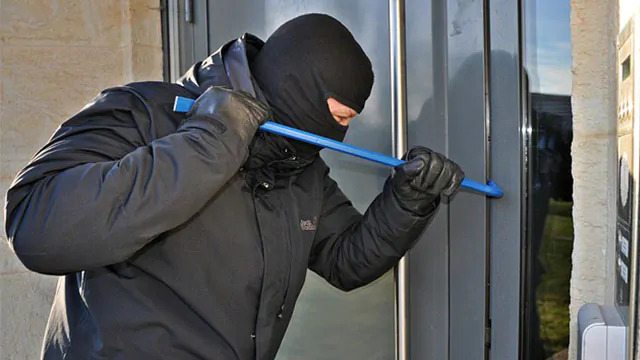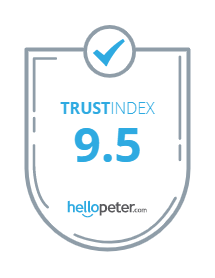How do you react to a break-in?

You take all sorts of security precautions to protect yourself as well as possible from such a scenario - and yet you can always be one of the unlucky ones to fall victim to a break-in. Below you will find a checklist of what you should definitely consider in this case and how you can deal with this situation step by step.
- keep calm
- do not torment yourself with self-reproach and
- act sensibly.

CASE 1 - FACE TO FACE WITH THE BURGLAR
The worst case – the burglar(s) are suddenly in front of you. They may be just as startled by the unexpected encounter that they immediately flee. Don't stop them from escaping, but memorize their appearance. If they are professionals, a confrontation with the residents of the house will not faze them, they may even have planned it in order to get the safe key immediately.
If the burglars demand valuables from you, the safe key or the right code for the electronic lock, you do not show any resistance, but hand over the objects and open the safe. Heroism is out of place. Follow the instructions of the burglars, stay calm and save many things in your brain - what do the perpetrators look like (beard, glasses, tall, short, slim, fat etc.), what clothes do they wear, do they speak broken English or does it sound like the mother tongue etc., every little hint can be helpful for the police.
The perpetrators leave the house with their loot and you are left shocked. Now call the police
and leave the crime scene as it is - don't put anything away, don't wipe anything to avoid losing traces (fingerprints). Try to breathe calmly, drink a glass of water, call someone you trust and, if you live alone, ask them to come so that someone is with you.

CASE 2 - YOU BELIEVE THERE ARE BURGLARS IN THE HOUSE
You are woken up by noises that you cannot identify and your first thought is someone is tampering here? Or are you just coming home and have the feeling that something is wrong here, that there are unauthorized persons in the house?
Get yourself to safety - try to leave the house unnoticed or do not enter it. Call a neighbor to let you in and call the police.
Share your name and address and what you noticed is there a car (license plate) nearby that you don't know?

CASE 3 - YOU DETECT A BREAK-IN
Perhaps you slept peacefully while the perpetrators cleared out the apartment?
And when you get up you realize that you have been the victim of a burglary.
Or you only notice the break-in later in the day because you are looking for a piece of jewelry or need a document.
WHAT TO DO AFTER THE BURGLARY?
Call the police and leave everything as it is – this applies to any burglary, regardless of how it was carried out, at what time, whether you were present or not. The police cannot do anything with a clean and tidy crime scene, valuable traces are lost in the process - fibers from clothing, dander, hair, fingerprints, etc.
You are only allowed to clean up after the police have taken photos or the evidence has been secured.
Go through the whole house/apartment with the police officers to determine how the burglars got into the house in the first place, whether there are any traces of objection, where there is damage, what was vandalized etc. and finally to determine which items were stolen.
After the forensic investigation is complete, you can take photos of the condition of your home yourself - so you can record what it looked like after the break-in - objects thrown over, drawers ransacked, signs of a break-in on the door, etc. These pictures are important for the insurance, so that the damage can be determined or an appropriate damage settlement can be carried out.
If credit cards, savings books or mobile phones have been stolen, have them blocked (e.g. by calling the emergency number 116 116, Visa hotline, contacting your bank regarding savings books, informing the mobile phone provider) so that the perpetrators cannot cause any more damage. Inform the district office/district authority about the theft of the passport, ID card or other documents.
Make a list of all stolen valuables (stolen goods list - forms are available for download). You may have a list of valuables including photos, which is of course helpful. It serves as proof of your valuables (watches, jewelry, electronic devices, coin collection, etc.) and enables you to determine what was actually stolen. The police may be able to use the list to locate stolen valuables. The more details are known (brands, manufacturers, special marks, proof of purchase), the better.
If you still have receipts for the valuables, these are the best evidence. The product description and approximate purchase date may make it easier for the seller to provide helpful information.
Ultimately, the burden of proof lies with the insured person and is relevant for the payment of the requested sum of money.
The list of valuables must be kept in a safe place (certified safe, safe deposit box). If there is a burglary and the perpetrator discovers them on the desk, all he has to do is look for these objects, they make his work easier.
If the safe is broken open and the list is discovered, then the valuables are probably in the safe anyway - unless they are valuable paintings, sculptures, carpets, etc.
Many burglars are opportunistic thieves and take whatever they can get their hands on on the spot. They want to leave the scene of the crime as quickly as possible so as not to be discovered. They rummage through cupboards and dressers, stuff jewelry and cash in their pockets, take wallets, smartphones, laptops, etc. with them. If they spot a safe, they quickly determine whether it is easy to open.
We recommend that you purchase a tested safe, as it cannot be cracked easily. (see paragraph Preventive protection - buying a safe at the end of our article).
Notify your insurance company as soon as possible, describe the course of events and hand over copies of the list of stolen goods, photos, etc. The household contents insurance will cover the damage incurred, unless gross negligence can be proven (balcony door left open, window tilted, unlocked front door, etc .). If this is the case, the insurance benefit will be reduced.
If damage has occurred to the building itself, an appraiser/expert may be called in.
Attempted break-in, nothing missing
If you suspect that a burglary has been attempted but failed, it is your decision whether to report the incident. Nothing was stolen, but the window may have been damaged. It is therefore advisable to also report a burglary attempt.
Check all security measures in place and perhaps implement additional security measures. Unfortunately, it happens that burglars become repeat offenders, that the first time they only got an overview of the obstacles to be expected.
One aspect that should not be underestimated in victims of burglary is the psychological damage. The shock of a burglary usually wears off after a few days, but long-term insecurities can remain deep-rooted and lead to anxiety and sleep disorders. Those affected have not only lost valuables, but also the feeling of still being safe in their own four walls.
Get professional help to make these conditions go away. Talking about the incident, with family, friends, or a professionally qualified person, will help you regain control of the fear of the fear.
Invest in new security devices to make your home a safe place again.
Preventive protection
Make your property safe. The list below gives you tips and hints on how to do this.
When leaving the house
All doors (do not forget the garage, workshop, etc.) should not only be closed, but also locked. The windows must not be tilted. The insurance gets out if it is proven that the perpetrator got in through an open balcony door or a tilted window!
Preventive protection
Make your property safe. The list below gives you tips and hints on how to do this.
When leaving the house
All doors (do not forget the garage, workshop, etc.) should not only be closed, but also locked. The windows must not be tilted. The insurance gets out if it is proven that the perpetrator got in through an open balcony door or a tilted window!
Ask neighbors to take care of your property - empty the post box, put out the garbage cans at the usual time, etc. The house should appear occupied, even when the owners are on vacation. Avoid hints that they are not present (beware of Facebook posts).
Safe lighting
Burglars love the dark, too much light interferes with their work. Install sufficient lighting in the entrance and driveway area and also in the garden. The areas are brightly lit by motion detectors and offer no retreat for burglars.
Using timers, you can program lamps, blinds, televisions, etc. and thus pretend that someone is at home. The home sweet home must appear lived in, not quiet and deserted.
How to enter the property
Not everyone wants to barricade themselves behind a strong wall, but we still recommend a secure fence or hedge enclosing the property. The more there is to overcome, the harder the target for a break-in becomes. If your house is freely accessible, then unfortunately it is not just for you.
Order in the garden/terrace
It may be annoying to put away ladders, garden furniture etc. every day. However, if they remain standing, possibly still leaning against a window, then they are ideal boarding aids for upper floors.
Equip windows and doors with security locks
Find out from a professional which lock makes the most sense for you. Security fittings, cylinder lock covers, etc. make the locks more resistant.
Safety glass windows offer a high degree of resistance and do not break simply by being smashed.
Alarm and intruder alarm systems
There is a wide range of alarm and intruder alarm systems. For example, there are alarm systems with connection to an emergency call/service center and alarm systems without connection. In the case of alarm systems without connection, a flashing light or a signal tone is triggered. An alarm system with activation is more effective protection against intruders, since the service center takes note of every alarm and responds accordingly.
Camera dummies are recognized by professional burglars, opportunistic thieves may feel insecure and give up before their intentions.
Note that the surveillance camera may only monitor your own property.
Have these safety devices installed by a specialist, he knows the legal regulations and knows where the appropriate place is, etc.
Purchase of a safe
Documents (birth or marriage certificates, citizenship contracts, certificates, passports, contracts, etc.) and valuables (jewellery, cash, coin collection, electronic devices, etc.) are best kept in a certified safe.
An non- certified safe has no security level and can only be insured with the insurance company.
Tested or certified safes, on the other hand, undergo a series of tests that have to meet criteria set across Europe. Independent test institutes - ESSA, VDS, etc. - carry out these certifications and the safes are classified into security classes.
The safe is tested with burglary tools (mechanical, electrical and thermal tools). The longer the time it takes for a safe to be broken into, the higher the resistance level and security level. We deliberately refrain from specifying times so that burglars do not have any information as to what to expect. Instead, it is referred to as resistance units (RU = Resistant Units).
Examples:
For example, a class EN 0 safe is double-walled, has a tested class 1 lock and guaranteed resistance units 30/30 RU. In Austria privately insurable up to € 20,000 and commercially up to € 10,000. Privately insurable in Germany up to € 40,000 and commercially up to € 10,000, --.
A class EN IV safe is multi-walled and has a special filling on all sides, has 2 tested class B locks according to EN 1300 and guaranteed resistance units of 120/180 RU. In AT and DE privately insurable up to € 400,000, --, commercially up to € 150,000, --.
The security level of the safe is therefore decisive for the insured values. (The stated maximum sums insured are non-binding information - every insurance company reacts somewhat differently, so it is important to contact the insurance company before buying a safe and to clarify which values should be insured).
A certified safe has a test plaque inside the safe that provides information about the test institute, security level, etc.
If you place particular value on fireproof accommodation, then you need a fireproof safe. Fire protection has nothing to do with burglary protection, but is certified in separate tests. The safes come in special fire protection ovens and are exposed to high temperatures, the internal temperature must not exceed a certain level.
SUMMARY
- Don't make it easy for burglars and protect your home with electronic and mechanical security devices.
- Do not be careless when leaving the house – lock it, close windows, put away access aids, etc.
- If, regrettably, there has been a burglary, the following must be observed:






